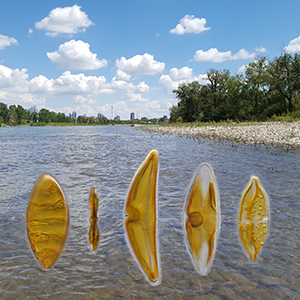Exploring diatom diversity through cultures - a case study from the Bow River, Canada

Accepted: 18 November 2022
HTML: 11
All claims expressed in this article are solely those of the authors and do not necessarily represent those of their affiliated organizations, or those of the publisher, the editors and the reviewers. Any product that may be evaluated in this article or claim that may be made by its manufacturer is not guaranteed or endorsed by the publisher.
Authors
Diatom cultures can help answer taxonomic, biogeographic and ecological questions on a local and global scale. Unialgal cultures are derived from a single cell and provide abundant material for morphological and molecular analyses. The link between the historic morphological species concept and the molecular data is becoming increasingly important with the use of eDNA metabarcoding. Additionally, cultures provide insights into the life cycle of diatoms and thereby complement taxonomy and species ecology. In this study, we present an approach to extract benthic diatoms from an environmental sample to generate unialgal cultures. We explored diatom diversity in preserved assemblages and by culturing as many different taxa as possible from benthic freshwater samples taken on the same day from the Bow River in Calgary, Canada. With both methods we found a total of 221 different benthic diatom taxa, of which 182 were identified in the preserved diatom assemblages. Interestingly, an additional 39 taxa only appeared in the cultures. In total 129 strains were cultivated representing 71 different taxa. This study includes pictures of living cells demonstrating the additional merits of unialgal cultures, as they provide information on plastid details, auxospores and endosymbionts. Both, the identification of the diatom assemblages and the generation and identification of strains provide the foundation for additional water quality assessment tools, taxonomic insights and molecular references libraries.
Edited by
Francesca Bona, Department of Life Sciences and Systems Biology, University of Turin, ItalySupporting Agencies
Verein der Freunde des Botanischen Gartens und Botanischen Museums Berlin Dahlem e.V. , Federal Ministry of Education and Research (German Barcode of Life 2 Diatoms, GBOL2)How to Cite

This work is licensed under a Creative Commons Attribution-NonCommercial 4.0 International License.
Similar Articles
- Giuseppe MORABITO, Delio RUGGIU, Pierisa PANZANI, Trends of phytoplankton characteristics and their communities in pre- and post-liming time in Lake Orta (1984-1998) , Journal of Limnology: Vol. 60 No. 1 (2001)
- Maria Letizia FILIPPI, Gayane PILIPOSIAN, Laura MARZIALI, Nicola ANGELI, Valeria LENCIONI, Marco CANTONATI, Is it possible to study palaeoenvironmental changes in Alpine spring habitats? A few examples from the south-eastern Alps (NE Italy) , Journal of Limnology: Vol. 70 No. s1 (2011): Springs: neglected key habitats for biodiversity conservation
- Linlin Ye, Xiaoli Shi, Xiaodong Wu, Fanxiang Kong, Nitrate limitation and accumulation of dissolved organic carbon during a spring-summer cyanobacterial bloom in Lake Taihu (China) , Journal of Limnology: Vol. 71 No. 1 (2012)
- Silvia Giuntini, Clara Tattoni, Alessandra Gagliardi, Alessio Martinoli, Nicola Patocchi, Roberto Lardelli, Adriano Martinoli, Damiano G. Preatoni, Dataset: bird traffic rate at Bolle di Magadino Natural Reserve, Lake Maggiore (Switzerland) , Journal of Limnology: Vol. 81 No. s2 (2022): Effects of water level management on lake littorals and downstream river areas
- Walter AMBROSETTI, Luigi BARBANTI, Evolution towards meromixis of Lake Iseo (Northern Italy) as revealed by its stability trend , Journal of Limnology: Vol. 64 No. 1 (2005)
- Sameer M. Padhye, Alexey A. Kotov, Neelesh Dahanukar, Henri Dumont, Biogeography of the ‘water flea’ Daphnia O. F. Müller (Crustacea: Branchiopoda: Anomopoda) on the Indian subcontinent , Journal of Limnology: Vol. 75 No. 3 (2016)
- Francine FORREST, Euan D. REAVIE, John P. SMOL, Comparing limnological changes associated with 19th century canal construction and other catchment disturbances in four lakes within the Rideau Canal system, Ontario, Canada , Journal of Limnology: Vol. 61 No. 2 (2002)
- Anna Cichy, Maria Urbańska, Anna Marszewska, Wojciech Andrzejewski, Elżbieta Żbikowska, The invasive Chinese pond mussel Sinanodonta woodiana (Lea, 1834) as a host for native symbionts in European waters , Journal of Limnology: Vol. 75 No. 2 (2016)
- Michał Niedźwiecki, Malgorzata Adamczuk, Tomasz Mieczan, Trophic interactions among the heterotrophic components of plankton in man-made peat pools , Journal of Limnology: Vol. 76 No. 3 (2017)
- Valeria ROSSI, Giorgio BENASSI, Francesco BELLETTI, Paolo MENOZZI, Colonization, population dynamics, predatory behaviour and cannibalism in Heterocypris incongruens (Crustacea: Ostracoda) , Journal of Limnology: Vol. 70 No. 1 (2011)
<< < 50 51 52 53 54 55 56 57 58 59 > >>
You may also start an advanced similarity search for this article.
-
Katherina Schimani, Nélida Abarca, Oliver Skibbe, Heba Mohamad, Regine Jahn, Wolf-Henning Kusber, Gabriela Laura Campana, Jonas ZimmermannMetabarcoding and Metagenomics : 2023

 https://doi.org/10.4081/jlimnol.2022.2095
https://doi.org/10.4081/jlimnol.2022.2095





